The Synergistic Effect of Urban Economic, Social and Space Factors on Residential Carbon Emissions: A Case Study on Provincial Capitals in China
Abstract
1. Introduction
2. Literature Research and Hypotheses
2.1. Carbon Reduction Effect of Spatial Environmental Comfort
2.2. The Impact of Social and Economic Factors on Carbon Emissions
2.3. Carbon Reduction Mechanism of Urban Public Facilities
3. Research Methods
3.1. Construction of Econometric Models
3.2. Data Sources and Variables
4. Calculation Results and Analysis
4.1. Characteristics of Residential Carbon Emissions
4.1.1. Overall Carbon Emissions
4.1.2. Residential Carbon Emission Intensity
4.2. Factors Affecting Carbon Emissions
4.2.1. Social and Economic Factors
4.2.2. Urban Space and Facility Factors
4.2.3. Synergistic Carbon Reduction Effect of Urban Elements
4.3. Robustness Testing
5. Conclusions
Author Contributions
Funding
Institutional Review Board Statement
Informed Consent Statement
Data Availability Statement
Acknowledgments
Conflicts of Interest
References
- Deng, J.-X.; Liu, X.; Wang, Z. Characteristics Analysis and Factor Decomposition Based on the Regional Difference Changes in China’s CO2 Emission. J. Nat. Resour. 2014, 29, 189–200. [Google Scholar]
- Zhou, J.; Shi, X.; Zhao, J.; Wang, Y.; Sun, L. On regional difference and influentialfactors of carbon emissions from direct living energy consumption of Chinese residents. J. Saf. Environ. 2019, 19, 954–963. [Google Scholar]
- Wang, S.; Su, Y.; Zhao, Y. Regional inequality, spatial spillover effects and influencing factors of China’s city-level energy-related carbon emissions. Acta Geogr. Sin. 2018, 73, 414–428. [Google Scholar]
- Yuan, X.; Zhong, Y. The Practice and System Construction of China′s Low carbon City. Urban Dev. Stud. 2010, 17, 42–47+58. [Google Scholar]
- Wang, S.J.; Gao, S.; Huang, Y.Y.; Shi, C.Y. Spatio-temporal evolution and trend prediction of urban carbon emission performance in China based onsuper-efficiency SBM model. Acta Geogr. Sin. 2020, 75, 1316–1330. [Google Scholar]
- Liu, Y.; He, S.; Jiang, Y.-J.; Luo, X.; Yuan, J.-H. Spatial-temporal decomposition of carbon emissions in China’s four major urban agglomerations. Clim. Chang. Res. 2024, 20, 231–241. [Google Scholar]
- Feng, D.; Li, J. Impacts of Urbanization on Carbon Dioxide Emissions in the Three Urban Agglomerations of China. Resour. Environ. Yangtze Basin 2018, 27, 2194–2200. [Google Scholar]
- Wang, Z.J.; Chen, F.; Fujiyama, T. Carbon emission from urban passenger transportation in Beijing. Transp. Res. Part D-Transp. Environ. 2015, 41, 217–227. [Google Scholar] [CrossRef]
- Jiang, J. Research on Household Commuting Carbon Emission of Metropolis in China: A Case Study of Wuhan. Ph.D. Thesis, Wuhan University, Wuhan, China, 2014. [Google Scholar]
- Zhang, J.; Yang, Y.; Chen, X.; Mao, Q. A Research on Neighborhood Built Environment and Household Travel Energy in Jinan. Urban Dev. Stud. 2013, 20, 83–89. [Google Scholar]
- Huang, J.N.; Du, N.R.; Liu, P.; Han, S.S. An Exploration of Land Use Mix Around Residence and Family Commuting Caused Carbon Emission: A Case Study of Wuhan City in China. Urban Plan. Int. 2013, 28, 25–30. [Google Scholar]
- Yang, W.; Li, T.; Cao, X. The spatial pattern of Community Travel Low Carbon Index (CTLCI) and spatial heterogeneity of the relationship between CTLCI and influencing factors in Guangzhou. Geogr. Res. 2015, 34, 1471–1480. [Google Scholar]
- Tang, C.; Yu, Y.; Yang, C.; Zhong, L.; Li, H. Analysis on low carbon cognition, willingness and behavior of tourists in Zhangjiajie National Forest Park. J. Arid Land Resour. Environ. 2018, 32, 43–48. [Google Scholar]
- Aguiléra, A.; Voisin, M. Urban form, commuting patterns and CO2 emissions: What differences between the municipality’s residents and its jobs? Transp. Res. Part A Policy Pract. 2014, 69, 243–251. [Google Scholar] [CrossRef]
- Singleton, A. A GIS approach to modelling CO2 emissions associated with the pupil-school commute. Int. J. Geogr. Inf. Sci. 2013, 28, 256–273. [Google Scholar] [CrossRef]
- Polloni-Silva, E.; Silveira, N.; Ferraz, D.; de Mello, D.S.; Moralles, H.F. The drivers of energy-related CO2 emissions in Brazil: A regional application of the STIRPAT model. Environ. Sci. Pollut. Res. 2021, 28, 51745–51762. [Google Scholar] [CrossRef]
- Henriques, S.T.; Borowiecki, K.J. The drivers of long-run CO2 emissions in Europe, North America and Japan since 1800. Energy Policy 2017, 101, 537–549. [Google Scholar] [CrossRef]
- Román-Collado, R.; Morales-Carrión, A.V. Towards a sustainable growth in Latin America: A multiregional spatial decomposition analysis of the driving forces behind CO2 emissions changes. Energy Policy 2018, 115, 273–280. [Google Scholar] [CrossRef]
- Meangbua, O.; Dhakal, S.; Kuwornu, J.K. Factors influencing energy requirements and CO2 emissions of households in Thailand: A panel data analysis. Energy Policy 2019, 129, 521–531. [Google Scholar] [CrossRef]
- Chong, C.H.; Tan, W.X.; Ting, Z.J.; Liu, P.; Ma, L.; Li, Z.; Ni, W. The driving factors of energy-related CO2 emission growth in Malaysia: The LMDI decomposition method based on energy allocation analysis. Renew. Sustain. Energy Rev. 2019, 115, 109356. [Google Scholar] [CrossRef]
- Reznik, A.; Kissinger, M.; Alfasi, N. Real-data-based high-resolution GHG emissions accounting of urban residents private transportation. Int. J. Sustain. Transp. 2019, 13, 235–244. [Google Scholar] [CrossRef]
- Nair, S.; Bhatia, S.K.; Chandrakar, M. Household Carbon Emissions in India: Correlation with Income and Household Size. Asian J. Water Environ. Pollut. 2019, 16, 71–81. [Google Scholar] [CrossRef]
- Wang, D.; Yuan, C. Modeling and forecasting household energy consumption and related CO2 emissions integrating UrbanSim and transportation models: An Atlanta BeltLine case study. Transp. Plan. Technol. 2018, 41, 448–462. [Google Scholar] [CrossRef]
- Hirano, Y.; Ihara, T.; Hara, M.; Honjo, K. Estimation of Direct and Indirect Household CO2 Emissions in 49 Japanese Cities with Consideration of Regional Conditions. Sustainability 2020, 12, 4678. [Google Scholar] [CrossRef]
- Yang, W.; Cao, X. The influence mechanism of travel-related CO2 emissions from the perspective of residential self-selection: A case study of Guangzhou. Acta Geogr. Sin. 2018, 73, 346–361. [Google Scholar]
- Ma, J.; Chai, Y.; Liu, Z. The Mechanism of CO2 Emissions from Urban Transport Based on Individuals’ Travel Behavior in Beijing. Acta Geogr. Sin. 2011, 66, 1023–1032. [Google Scholar]
- Zhu, M.; Wang, C.; Chen, J. Identification of Key Influences on the Perception of Safety at Night in Street Walking Environment: Walking Perception Experiments Based on Wearable Physiological Sensors. Chin. Landsc. Archit. 2023, 39, 64–69. [Google Scholar]
- Chen, Y.; Wang, Q.Y.; Xi, W.Q.; Mao, J. Influence of Spatial Form on Pedestrians. Planners 2017, 33, 74–80. [Google Scholar]
- Chen, W.; Ge, Y. The Influence Mechanism of Road Environment on Travel Choice from the Low-Carbon Perspective: An Empirical Research Based on Multinomial Logit Model. Ecol. Econ. 2018, 34, 37–42. [Google Scholar]
- Su, S. The Effects of Walking Environment on Pedestrian Security Requirement and Travel Activities. Ph.D. Thesis, Chang’an University, Xi’an, China, 2017. [Google Scholar]
- Lee, J.S.; Park, S.; Jung, S. Effect of Crime Prevention through Environmental Design (CPTED) Measures on Active Living and Fear of Crime. Sustainability 2016, 8, 872. [Google Scholar] [CrossRef]
- Qin, Q.; Yuan, Z.; Tian, J. Method of Slow Traffic Planning in the Concept of Green Transportation Research. Planners 2012, 28, 5–10. [Google Scholar]
- Ma, L.; Xiu, C. Research on the matching of park green space and residential function in Shenyang based on the perspective of residents’ leisure travel. World Reg. Stud. 2023, 32, 108–118. [Google Scholar]
- Xing, L.; Du, S.; Tong, Z.; Zhang, L. Spatial and temporal accessibility of urban green space and its influencing factors in Wuhan from the perspective of environmental justice. Acta Ecol. Sin. 2023, 43, 5370–5382. [Google Scholar]
- Zhang, J.F.; Zhang, L.J.; Qin, Y.C.; Wang, X.; Sun, Y.Y.; Rong, P.J. Influencing factors of low-carbon behaviors of residents in Zhengzhou City from the perspective of cognition-behavior gaps. Prog. Geogr. 2020, 39, 265–275. [Google Scholar] [CrossRef]
- Mi, L.Y.; Gu, M.; Yang, J.; Yu, X.; Liu, Y. Empirical research on the psychological motivation factors of urban residents’ low carbon oriented energy consumption behavior in Xuzhou City. Resour. Sci. 2016, 38, 609–621. [Google Scholar]
- Liu, D. Green Transport: A Transport Philosophy of Sustainable Development. Mod. Urban Res. 2003, 01, 60–63. [Google Scholar]
- Chen, L. Study on Urban Residential Energy Consumption Behavior. Ph.D. Thesis, Dalian University of Technology, Dalian, China, 2009. [Google Scholar]
- Ding, Z.H.; Wang, G.Q.; Liu, Z.H.; Long, R.Y. Research on differences in the factors influencing the energy-saving behavior of urban and rural residents in China—A case study of Jiangsu Province. Energy Policy 2017, 100, 252–259. [Google Scholar] [CrossRef]
- Munshi, T. Built environment and mode choice relationship for commute travel in the city of Rajkot, India. Transp. Res. Part D Transp. Environ. 2016, 44, 239–253. [Google Scholar] [CrossRef]
- Zhang, Y.; Hu, S.; Chen, X.; Zhao, L. The Impact of Urban Built Environment on Residential Choice of Commuting Mode: Based on Empirical Research in Fuzhou. Urban Dev. Stud. 2019, 26, 72–78. [Google Scholar]
- Chen, L.; Wang, J.; Chen, Z.; Zhou, L. Chinese household income and household carbon peaking: Based on CGSS data and multinomial Logit model. China Soft Sci. 2024, 4, 166–175. [Google Scholar]
- Wang, X.; Song, Y.; Xu, J. Comparative Study on Food Consumption Prices among Regional Residents—Analysis based on purchasing power parity perspective. Price Theory Pract. 2023, 11, 93–99+156. [Google Scholar]
- Shen, L.; Zhang, C.; Li, H.; Wang, Y. Interaction between commuting modes and job-housing imbalance in metropolis: An empirical study by Bayesian-tobit analysis in Beijing. Prog. Geogr. 2018, 37, 1277–1290. [Google Scholar]
- Liu, Q.; Zhang, Y.; Xiao, Y.; Yuan, Y.; Xia, H. Characteristics and determinants of carbon emissions from daily private cars travel in central area of Jinan. Resour. Sci. 2018, 40, 262–272. [Google Scholar]
- Ding, C.; Wang, Y.; Lin, Y. Exploration on the Relationship between Transit-City Strategy and Tod Mode: From the Perspective of Low Carbon Travel. City Plan. Rev. 2013, 11, 54–61. [Google Scholar]
- Lin, H.; Li, J. Relationship between Spatial Distribution of Resident Trips and Mixed Degree of Land Use: A Case Study of Guangzhou. City Plan. Rev. 2008, 9, 53–56+74. [Google Scholar]
- Wang, Q. Urban New Development Mode Based on Large-scale Public Facility. Mod. Urban Res. 2008, 23, 47–53. [Google Scholar]
- Le, J.; Ye, K. Research on optimization of public facilities development path in new urban district. Urban Dev. Stud. 2019, 026, 133–140. [Google Scholar]
- Chen, Y.P.; Song, Y.; Zhang, Y.; Peng, K.; Zhang, Q.; Jin, X. Impact of Land Use Development on Travel Mode Choice: A Case Study in Shenzhen. Urban Transp. China 2011, 9, 80–85+27. [Google Scholar]
- Guo, L.; Peng, Y.; Huang, J.; Feng, J.; Hu, G.; Sun, X. Identification and Optimization of Spatial Elements in Short Distance Commuting for Green Travel: Taking Wuhan as an Example. Urban Plan. Forum 2022, 3, 37–43. [Google Scholar]
- Gehrke, S.R.; Wang, L. Operationalizing the neighborhood effects of the built environment on travel behavior. J. Transp. Geogr. 2020, 82, 102561. [Google Scholar] [CrossRef]
- Zhang, T.; Zhou, Y.; Zhao, X. Analysis on the Status and Development Path of the China’s Urban Low-carbon Transport. Urban Dev. Stud. 2011, 18, 68–73+80. [Google Scholar]
- Pan, H. Urban Spatial Structure towards Low Carbon: New Urban Transport and Land Use Model. Urban Plan. Forum 2010, 17, 40–45. [Google Scholar]
- Xiao, Z.; Chai, Y.; Liu, Z. Quantitative Distribution and Related Factors for Household Daily Travel CO2 Emissions in Beijing. Urban Dev. Stud. 2011, 18, 104–112. [Google Scholar]
- Li, Q.; Chen, J.; Tang, L. Inventory-algorithm-based carbon emission characteristics in regional energy systems, Sichuan Province. Nat. Gas Technol. Econ. 2022, 16, 50–56. [Google Scholar]
- Jiang, J. An Evaluation and Decomposition Analysis of Carbon Emissions in China. Resour. Sci. 2011, 33, 597–604. [Google Scholar]
- Sun, Q.; Chen, H.; Long, R.; Zhang, J.; Yang, M.; Huang, H.; Ma, W.; Wang, Y. Can Chinese cities reach their carbon peaks on time? Scenario analysis based on machine learning and LMDI decomposition. Appl. Energy 2023, 347, 121427. [Google Scholar] [CrossRef]
- Jin, Y.; Wang, W. Information Entropy Change of Land Use Structure in Zhangye City Research on its Driving Factors. China For. Econ. 2020, 4, 24–27+31. [Google Scholar]
- Xu, Z.; Li, C.; Niu, L. Decoupling Relationship between Land Mixed Use and Carbon Emissions in Hohhot-Baotou-Ordos-Yulin Urban Agglomeration. Res. Environ. Sci. 2022, 35, 299–308. [Google Scholar]
- Tan, J.; Zhu, H.-M.; Jin, W.-H. Analysis on Information Entropy of Land Use Structure in Changsha City. Econ. Geogr. 2010, 19, 1400–1416. [Google Scholar]
- Zhou, M.; Zhao, R.Q.; Yuan, Y.C.; Feng, D.X.; Yang, Q.L.; Wang, S.; Yang, W.J. Impact of Land-mixing Degree of Residential Area on Carbon emissions of Commuting: A Case Study of Typical Residential district, Jiangning District, Nanjing. Hum. Geogr. 2018, 33, 70–75. [Google Scholar]
- Sadik-Zada, E.R.; Gatto, A. The puzzle of greenhouse gas footprints of oil abundance. Socio-Econ. Plan. Sci. 2020, 75, 100936. [Google Scholar] [CrossRef]
- Hong, S.; Hui, E.C.M.; Lin, Y. Relationships between carbon emissions and urban population size and density, based on geo-urban scaling analysis: A multi-carbon source empirical study. Urban Clim. 2022, 46, 101337. [Google Scholar] [CrossRef]
- Fang, C.; Li, G.; Zhang, Q. The Variation Characteristics and Control Measures of the Urban Construction Land in China. J. Nat. Resour. 2017, 32, 363–376. [Google Scholar]
- Rosca, E.; Costescu, D.; Rusca, F.V.; Burciu, S. Assessing the Effect of Traffic Congestion on Greenhouse Gas Emissions. In Proceedings of the International Conference on Traffic and Transport Engineering, Belgrade, Serbia, 27–28 November 2014. [Google Scholar]
- Li, C.; Lei, A.; Wu, X.; Hong, T. Game mode of choice of urban public transportation travel mode. Technol. Econ. Areas Commun. 2022, 3, 18–24. [Google Scholar]
- Sham, R.; Othman, R.; Yee, H.H.; Han, T.Y. Promoting a Lower Carbon Footprint using an Enhanced Pedestrian-Friendly Model. Environ. Behav. Proc. J. 2020, 13, 157–164. [Google Scholar] [CrossRef]
- Liu, X.; Xu, H.; Zhang, M. The effects of urban expansion on carbon emissions: Based on the spatial interaction and transmission mechanism. J. Clean. Prod. 2024, 434, 140019. [Google Scholar] [CrossRef]
- Sun, Y.; Zhang, Y.; Liu, X. Driving Factors of Transportation CO2 Emissions in Beijing: An Analysis from the Perspective of Urban Development. Chin. J. Urban Environ. Stud. 2020, 3, 2050013. [Google Scholar] [CrossRef]
- Verburg, P.H.; Soepboer, W.; Veldkamp, A.; Limpiada, R.; Espaldon, V.; Mastura, S.S. Modeling the spatial dynamics of regional land use: The CLUE-S model. Environ. Manag. 2002, 30, 391–405. [Google Scholar] [CrossRef]
- Fan, Q.; Wang, Y. Temporal and spatial change detecting (1998–2003) and predicting of land use and landcover in core corridor of Pearl River Delta (China) by using TM and ETM+ images. Environ. Monit. Assess. 2008, 137, 127–147. [Google Scholar] [CrossRef] [PubMed]
- GB 50137-2011; The Code for Classification of Urban Land Use and Planning Standards of Development Land. China Architecture & Building Press: Beijing, China, 2011.
- Wang, S.; Hong, J. Impact of Population Agglomeration on Haze Pollution under the Threshold of Economic Growth. J. Jiangsu Ocean. Univ. Humanit. Soc. Sci. Ed. 2022, 20, 81–90. [Google Scholar]
- Xu, B.; Hu, J. Digital Finance Development and Human Capital Promotion: Empirical Evidence based on the Prefecture Level Cities in China. J. Tech. Econ. Manag. 2022, 12, 81–87. [Google Scholar]

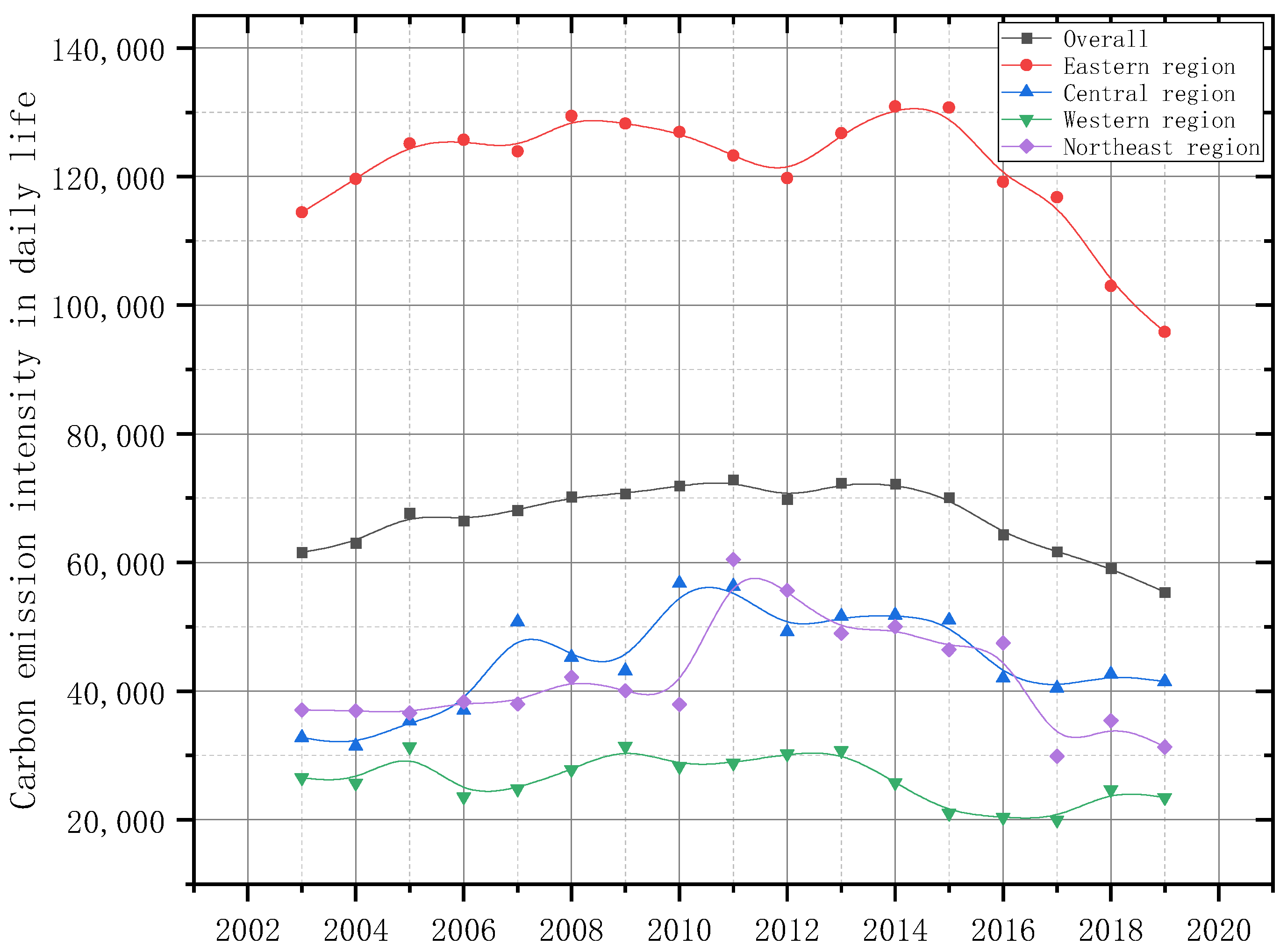


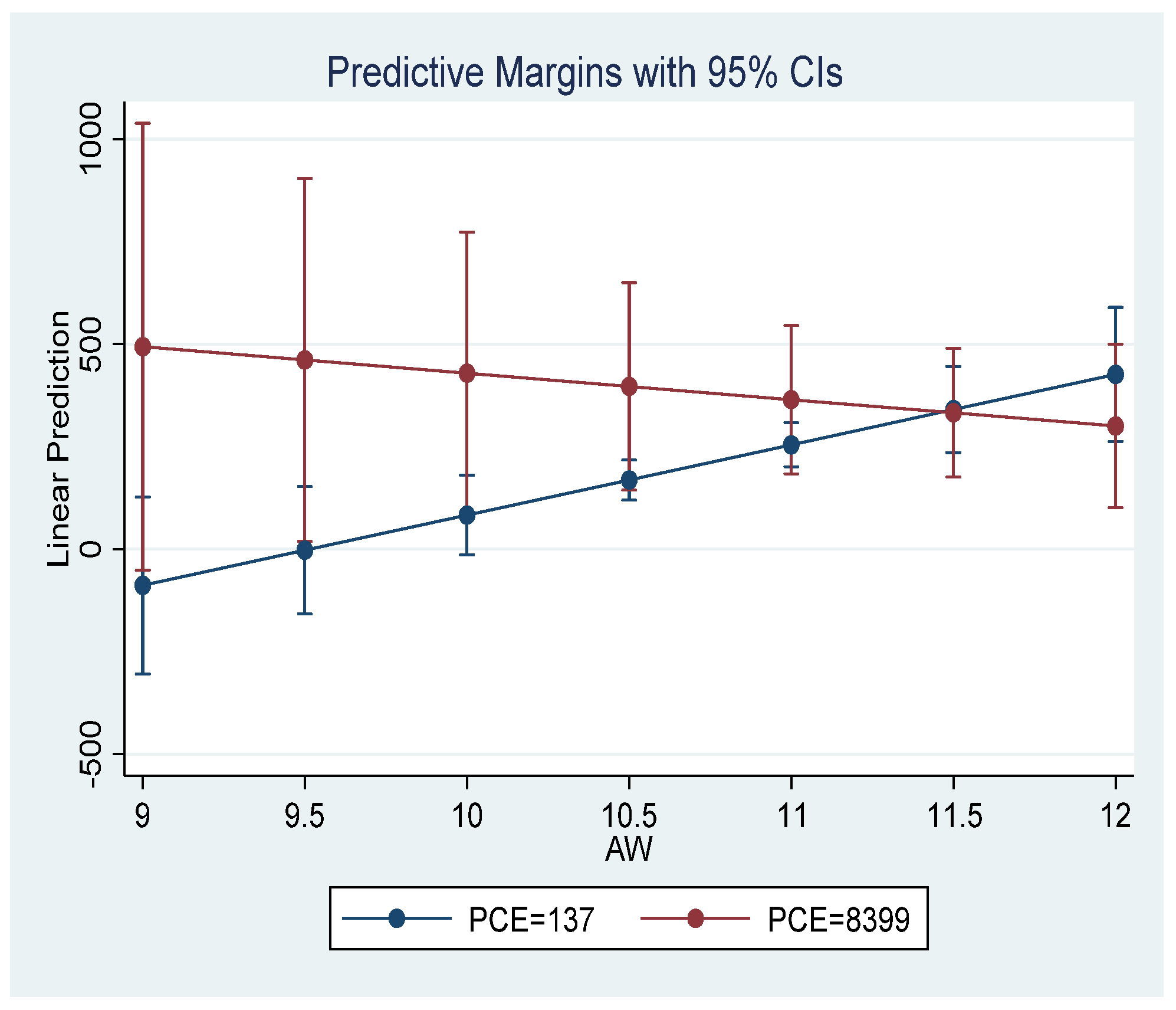
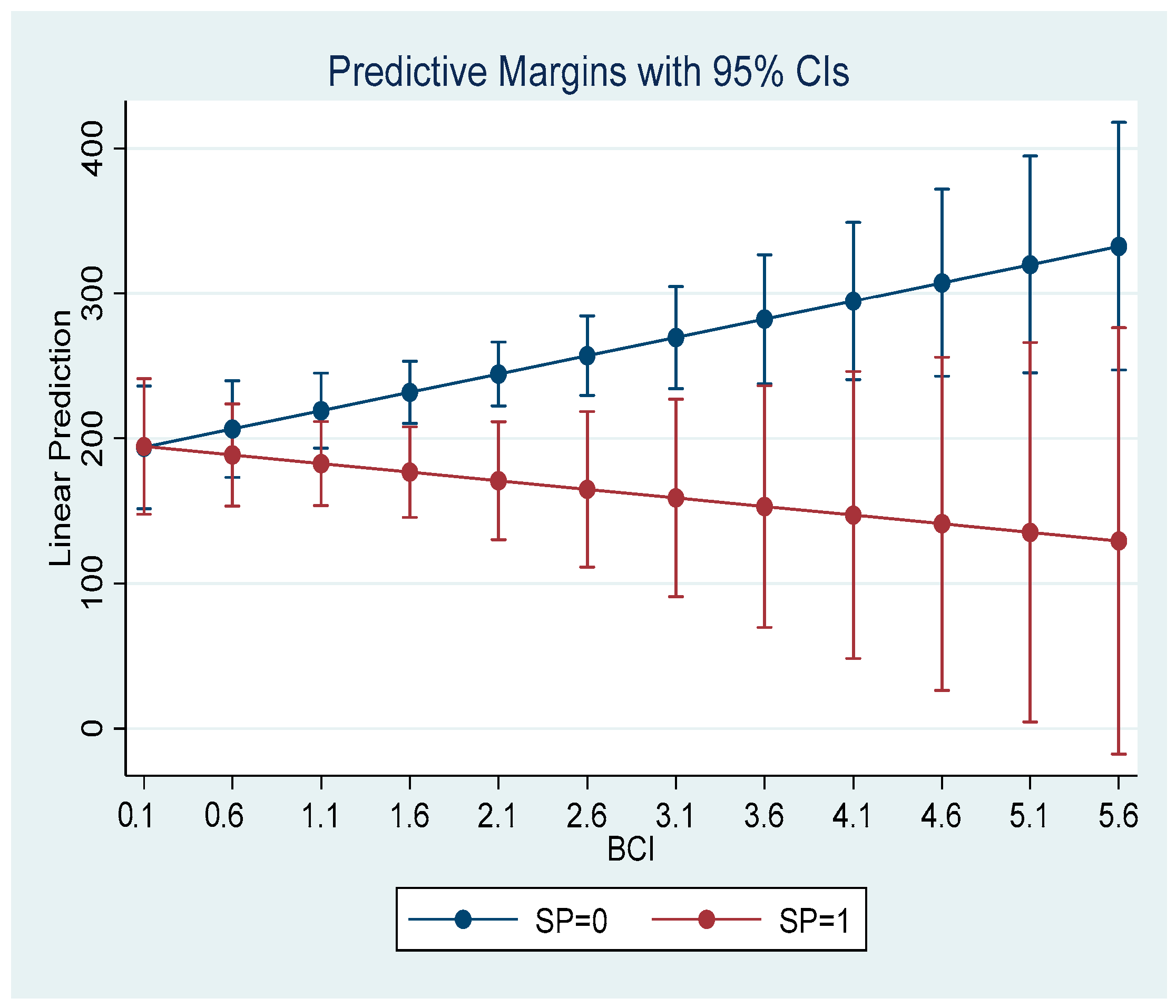
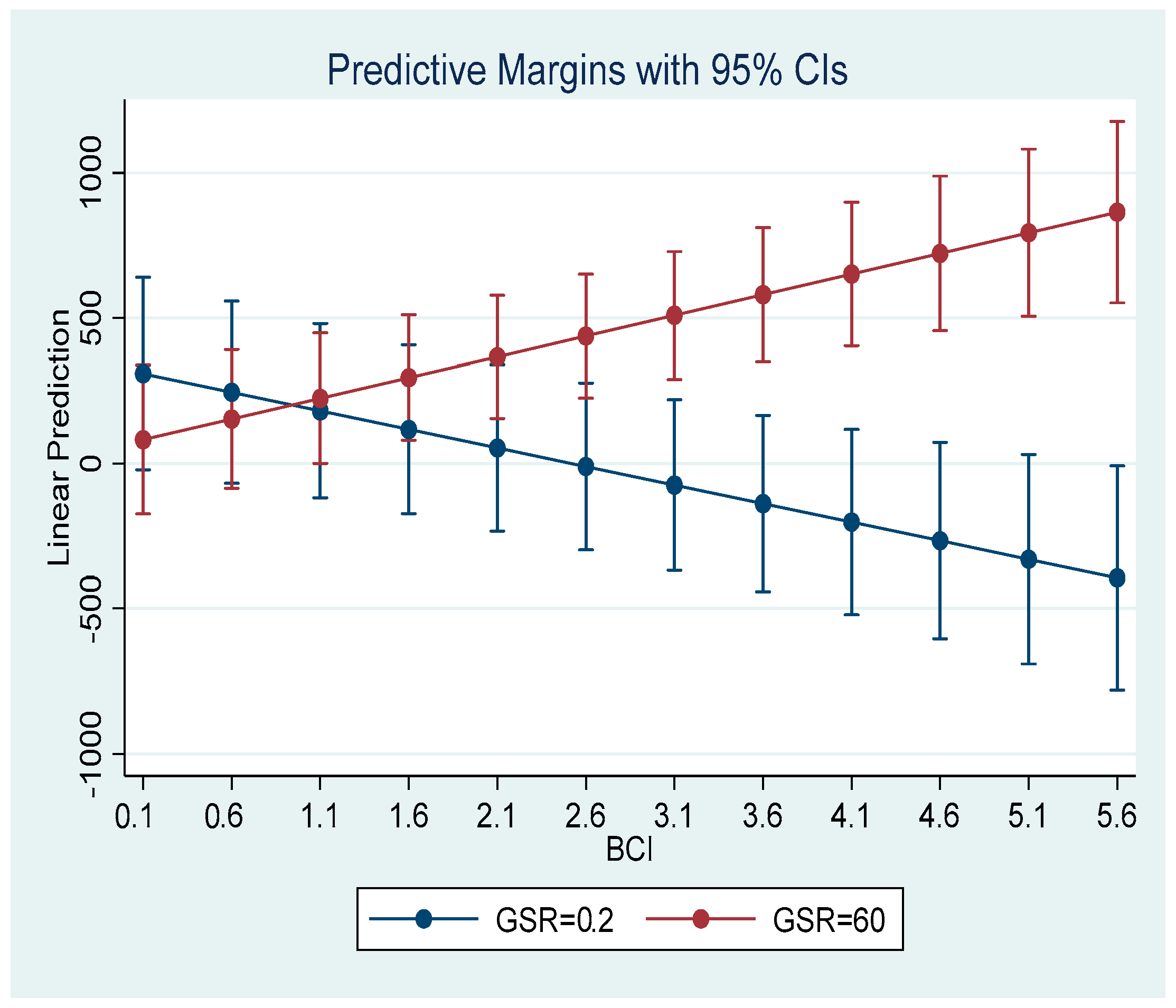
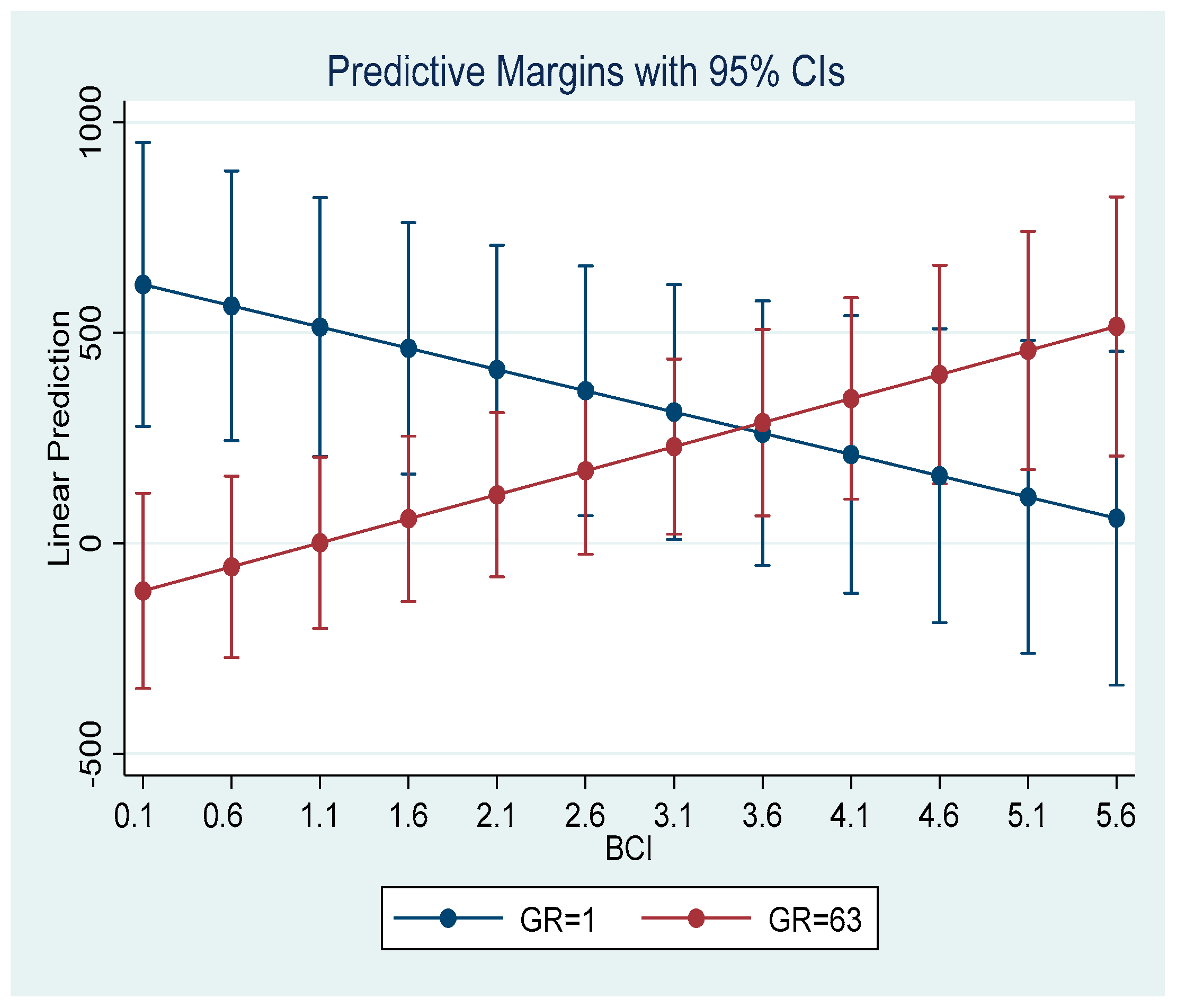

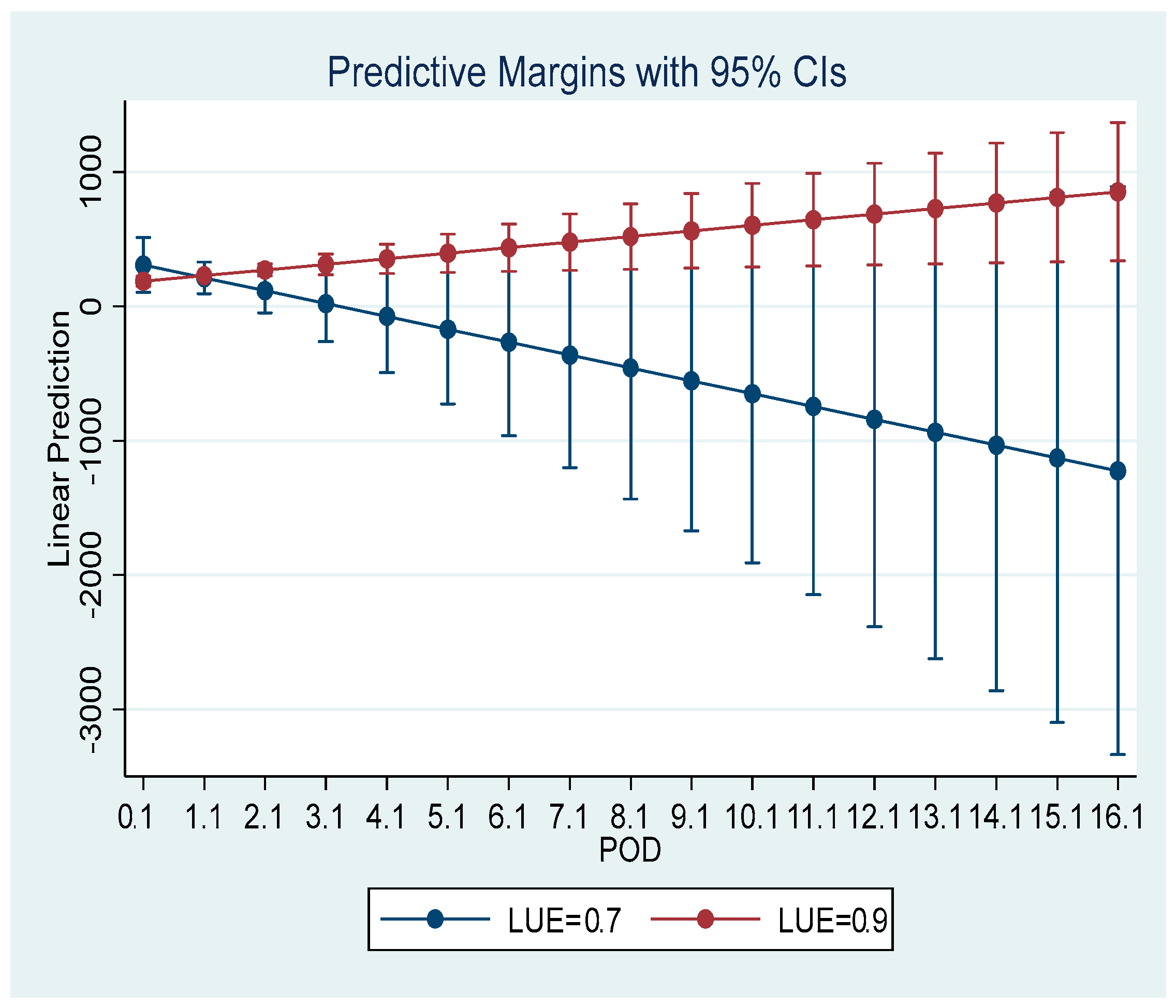
| Variables | Model 1 | Model 2 | Model 3 |
|---|---|---|---|
| Bus configuration intensity^2 | —— | —— | −8.757 * |
| Number of parks^2 | —— | −0.003 *** | —— |
| Average wage | 126.358 ** | 117.067 ** | 121.198 ** |
| Per capital education expenditure | −0.004 | −0.004 | −0.002 |
| Total retail sales of consumer goods | −10.075 | −11.149 | −10.185 |
| Fiscal revenue | −16.491 | −19.628 | −20.277 |
| Urban built-up area | 0.208 * | 0.125 * | 0.196 * |
| GDP | −107.479 ** | −95.924 ** | −105.707 ** |
| Night lighting | 0.011 | 0.016 | 0.012 |
| Population density | 17.031 ** | 16.798 ** | 16.522 ** |
| Land use equilibrium degree | 172.728 | 196.146 | 123.180 |
| Subway presence | −37.852 * | −46.348 ** | −36.112 * |
| Bus configuration intensity | 16.349 | 12.783 * | 60.334 * |
| Greening rate | −4.645 | −4.114 | −5.177 |
| Green space ratio | 6.066 | 6.028 | 5.782 |
| Number of parks | −0.879 *** | 0.908 | −0.866 *** |
| Green area | 34.662 *** | 29.108 *** | 41.967 *** |
| Per capital public green space area | −39.876 * | −43.058 * | −36.360 * |
| Public facility investment | 0.00000187 | 0.00000204 | 0.00000296 |
| Constant term | 456.525 | 498.611 | 396.689 |
| Prob > F | 0.000 | 0.000 | 0.000 |
| Variables | Model 4 | Model 5 | Model 6 | Model 7 | Model 8 | Model 9 |
|---|---|---|---|---|---|---|
| Average wage #c. per capita education expenditure | −0.0286 ** | —— | —— | —— | —— | —— |
| Subway presence #c. bus configuration intensity | —— | −37.069 ** | —— | —— | —— | —— |
| Bus configuration intensity #c. greening rate | —— | —— | 3.471 *** | —— | —— | —— |
| Bus configuration intensity #c. green space ratio | —— | —— | —— | 4.518 *** | —— | —— |
| Urban built-up area #c. GDP | —— | —— | —— | —— | 0.040 * | —— |
| Population density #c. land use equilibrium degree | 686.180 * | |||||
| Average wage | 175.505 *** | 125.930 ** | 117.001 ** | 123.366 ** | 121.113 ** | 120.340 ** |
| Per capita education expenditure | 0.328 ** | −0.006 | −0.002 | −0.0007 | −0.007 | −0.005 |
| Total retail sales of consumer goods | −14.296 | −9.505 | −8.154 | −6.716 | −9.624 | −8.744 |
| Fiscal revenue | −53.049 | −8.184 | −25.033 | −29.280 | 1.351 | −15.583 |
| Urban built-up area | 0.248 ** | 0.190 * | 0.201 * | 0.189 * | −0.545 | 0.187 * |
| GDP | −112.17 ** | −112.238 ** | −105.561 ** | −105.02 ** | −125.536 ** | −105.452 ** |
| Night lighting | 0.003 | 0.009 | 0.017 | 0.020 | 0.013 | 0.031 |
| Population density | 17.212 ** | 17.897 ** | 14.554 ** | 14.240 ** | 16.560 ** | −576.019 |
| Land use equilibrium degree | 209.084 | 322.253 | 129.919 | 93.583 | 88.126 | −672.491 |
| Subway presence | −34.573 ** | 4.339 * | −28.583 * | −30.719 * | −35.887 * | −38.400 * |
| Bus configuration intensity | 15.743 | 25.226 ** | −104.41 ** | −128.742 *** | 14.051 | 12.447 |
| Greening rate | −3.786 | −3.751 | −12.086 ** | −5.408 | −5.505 | −5.246 |
| Green space ratio | 5.424 | 5.932 | 4.984 | −4.250 | 6.762 | 6.593 |
| Number of parks | −0.881 *** | −0.879 *** | −0.793 ** | −0.767 *** | −0.889 | −0.919 *** |
| Green area | 36.018 *** | 34.697 *** | 41.882 *** | 41.536 *** | 34.779 *** | 36.190 *** |
| Per capita public green space area | −43.941 ** | −42.052 ** | −31.007 ** | −29.99 * | −39.337 * | −37.166 * |
| Public facility investment | 0.00000319 | 0.00000166 | 0.00000139 | 0.000000747 | 0.000000179 | 0.00000328 |
| Constant term | 539.835 | 272.096 | 745.457 | 806.111 | 659.022 | 1152.12 |
| Prob > F | 0.000 | 0.000 | 0.000 | 0.000 | 0.000 | 0.000 |
| Variables | T-Model 1 | T-Model 2 | T-Model 3 | T-Model 4 | T-Model 5 | T-Model 6 | T-Model 7 | T-Model 8 | T-Model 9 |
|---|---|---|---|---|---|---|---|---|---|
| Population density #c. land use equilibrium degree | —— | —— | —— | —— | —— | —— | —— | —— | 371.060 * |
| Urban built-up area #c. GDP | —— | —— | —— | —— | —— | —— | —— | 0.0667 * | —— |
| Bus configuration intensity #c. green space ratio | —— | —— | —— | —— | —— | —— | 5.319 *** | —— | —— |
| Bus configuration intensity #c. greening rate | —— | —— | —— | —— | —— | 4.096 *** | —— | —— | —— |
| Subway presence #c. bus configuration intensity | —— | —— | —— | —— | −39.112 ** | —— | —— | —— | —— |
| Average wage #c. per capita education expenditure | —— | —— | —— | −0.032 ** | —— | —— | —— | —— | —— |
| Bus configuration intensity^2 | —— | —— | −7.288 * | —— | —— | —— | —— | —— | —— |
| Number of parks^2 | —— | −0.003 ** | —— | —— | —— | —— | —— | —— | —— |
| Average wage | 118.456 * | 106.181 | 114.311 * | 178.840 ** | 115.907 * | 103.350 * | 109.142 * | 111.131 * | 114.784 * |
| Per capita education expenditure | 0.002 | −0.001 | −0.003 | 0.373 ** | 0.0001 | 0.004 | 0.005 | −0.003 | 0.001 |
| Total retail sales of consumer goods | −0.773 | −1.618 | −0.564 | −4.451 | 1.456 | 0.468 | 1.808 | −0.299 | −0.135 |
| Fiscal revenue | −25.04536 | −28.497 | −28.723 | −65.874 | −14.796 | −39.149 | −45.515 | −38.759 | −23.474 |
| Urban built-up area | 0.240 * | 0.147 * | 0.229 * | 0.282 ** | 0.213 * | 0.228 ** | 0.211 * | −0.994 * | 0.232 * |
| Night lighting | 0.025 | 0.029 | 0.026 | 0.016 | 0.021 | 0.033 | 0.035 | 0.027 | 0.034 |
| Population density | 17.320 ** | 16.967 *** | 16.995 ** | 17.380 ** | 18.071 ** | 14.906 | 14.618 ** | 16.721 ** | −303.404 |
| Land use equilibrium degree | 171.039 | 192.887 | 124.988 | 181.700 | 325.597 | 110.660 | 67.897 | 57.089 | −271.105 |
| Bus configuration intensity | 15.141 | 11.323 | 52.071 | 14.972 | 24.034 | −126.01 *** | −154.25 *** | 11.266 | 12.871 |
| Greening rate | −3.510 | −3.096 | −3.992 | −2.585 | −2.629 | −12.566 ** | −4.907 | 5.363 | −3.794 |
| Green space ratio | 4.462 | 4.594 | 4.249 | 3.773 | 4.483 | 3.403 | −7.197 | −4.788 | 4.798 |
| Number of parks | −1.015 *** | 0.809 *** | −1.000 *** | −1.015 *** | −1.014 *** | −0.888 ** | −0.848 ** | −1.045 *** | −1.040 *** |
| Green area | 34.967 *** | 29.322 *** | 41.447 *** | 36.687 *** | 34.598 *** | 44.874 *** | 44.781 *** | 34.733 *** | 35.613 *** |
| Subway presence | −41.573 * | −48.758 ** | −39.958 * | −37.762 * | 0.798 | −31.945 * | −34.927 * | −38.087 * | −41.813 * |
| Per capita public Green space area | −42.207 * | −44.413 * | −39.195 * | −45.986 ** | −44.176 * | −33.015 * | −32.017 * | −41.577 * | −41.111 * |
| GDP | −102.954 * | −89.109 * | −101.197 * | −113.409 ** | −108.341 ** | −92.456 * | −89.145 * | −133.272 ** | −102.766 * |
| Public facility investment | −1.01 × 10−6 | −6.55 × 10−7 | −5.90 × 10−8 | 4.01 × 10−7 | −3.54 × 10−6 | −9.49 × 10−7 | −1.58 × 10−6 | −4.23 × 10−6 | −4.04 × 10−7 |
| Constant term | 456.225 | 491.294 | 399.758 | 579.820 | 252.489 | 767.461 | 831.375 | 785.701 | 827.725 |
| Prob > F | 0.000 | 0.000 | 0.000 | 0.000 | 0.000 | 0.000 | 0.000 | 0.000 | 0.000 |
Disclaimer/Publisher’s Note: The statements, opinions and data contained in all publications are solely those of the individual author(s) and contributor(s) and not of MDPI and/or the editor(s). MDPI and/or the editor(s) disclaim responsibility for any injury to people or property resulting from any ideas, methods, instructions or products referred to in the content. |
© 2024 by the authors. Licensee MDPI, Basel, Switzerland. This article is an open access article distributed under the terms and conditions of the Creative Commons Attribution (CC BY) license (https://creativecommons.org/licenses/by/4.0/).
Share and Cite
Hang, S.; Juntao, Y. The Synergistic Effect of Urban Economic, Social and Space Factors on Residential Carbon Emissions: A Case Study on Provincial Capitals in China. Sustainability 2024, 16, 5153. https://doi.org/10.3390/su16125153
Hang S, Juntao Y. The Synergistic Effect of Urban Economic, Social and Space Factors on Residential Carbon Emissions: A Case Study on Provincial Capitals in China. Sustainability. 2024; 16(12):5153. https://doi.org/10.3390/su16125153
Chicago/Turabian StyleHang, Su, and Yang Juntao. 2024. "The Synergistic Effect of Urban Economic, Social and Space Factors on Residential Carbon Emissions: A Case Study on Provincial Capitals in China" Sustainability 16, no. 12: 5153. https://doi.org/10.3390/su16125153
APA StyleHang, S., & Juntao, Y. (2024). The Synergistic Effect of Urban Economic, Social and Space Factors on Residential Carbon Emissions: A Case Study on Provincial Capitals in China. Sustainability, 16(12), 5153. https://doi.org/10.3390/su16125153





